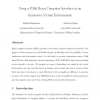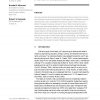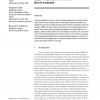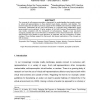439 search results - page 8 / 88 » Measuring presence in virtual environments |
PRESENCE
2010
13 years 6 months ago
2010
Brain-computer interfaces (BCIs) provide a novel form of human-computer interaction. The purpose of these systems is to aid disabled people by aording them the possibility of com...
PRESENCE
1998
13 years 7 months ago
1998
Virtual environments are envisioned as being systems that will enhance the communication between humans and computers. If virtual systems are to be effective and well received by ...
PRESENCE
2000
13 years 7 months ago
2000
Observers adjusted a pointer to match the depicted distance of a monocular virtual object viewed in a see-through, head-mounted display. Distance information was available through...
VRST
2006
ACM
14 years 1 months ago
2006
ACM
This paper describes an experiment that examines the influence of visual realism on reported presence. 33 participants experienced two different renderings of a virtual environmen...
PSYCHNOLOGY
2010
13 years 6 months ago
2010
The concept of self-presence provides a framework for understanding how people connect to virtual self-representations on three distinct levels (body, emotions, and identity). The...




